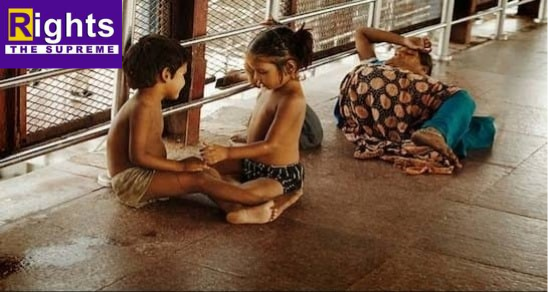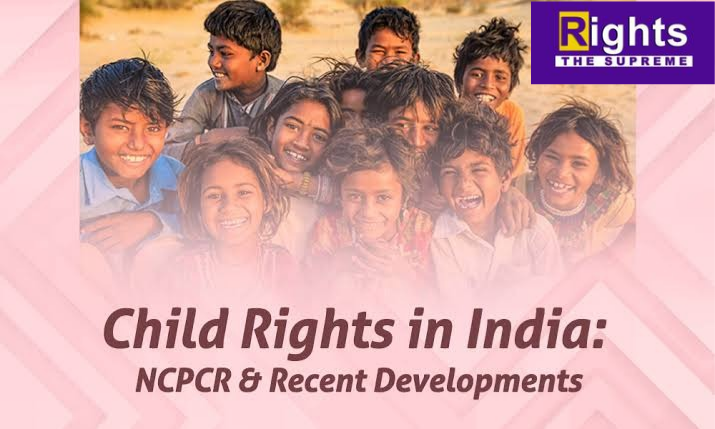This is the second part of my previous article on NCPCR, which will be dealing with legal provisions, child beggars and Judicial pronouncements for CiSS.
LEGAL PROVISIONS
Section 2(14) of the JJ Act, 2015defines child in need of care and protection as a child:
(i) who is found without any home or settled place of abode and without any ostensible means of subsistence; or
(ii) who is found working in contravention of labour laws for the time being in force or is found begging, or living on the street; or
(iii) who resides with a person (whether a guardian of the child or not) and such person—
(a) has injured, exploited, abused or neglected the child or has violated any other
law for the time being in force meant for the protection of child; or
(b) has threatened to kill, injure, exploit or abuse the child and there is a reasonable likelihood of the threat being carried out; or
(c) has killed, abused, neglected or exploited some other child or children and there is a reasonable likelihood of the child in question being killed, abused, exploited or neglected by that person; or
(iv) who is mentally ill or mentally or physically challenged or suffering from terminal or incurable disease, having no one to support or look after or having parents or guardians unfit to take care, if found so by the Board or the Committee; or
(v) who has a parent or guardian and such parent or guardian is found to be unfit or incapacitated, by the Committee or the Board, to care for and protect the safety and well-being of the child; or
(vi) who does not have parents and no one is willing to take care of, or whose parents have abandoned or surrendered him; or
(vii) who is missing or run away child, or whose parents cannot be found after making reasonable inquiry in such manner as may be prescribed; or
(viii) who has been or is being or is likely to be abused, tortured or exploited for the purpose of sexual abuse or illegal acts; or
(ix) who is found vulnerable and is likely to be inducted into drug abuse or trafficking; or
(x) who is being or is likely to be abused for unconscionable gains; or
(xi) who is child of or affected by any armed conflict, civil unrest or natural calamity; or
(xii) who is at imminent risk of marriage before attaining the age of marriage and whose parents, family members, guardian and any other persons are likely to be responsible for solemnization of such marriage.
❖ The principle adopted and reflected in JJ Act, 2015, that any child/children who come under the category of CNCP is to be produced before the CWC, is established under Section 27 of the Act.
❖ It may be noted that under the juvenile justice system, there are two categories of children, namely, children in conflict with law (CICL) and children in need of care and protection(CNCP), to be dealt by the Juvenile Justice Board (JJB) and Child Welfare Committee (CWC), respectively. According to JJ Act, 2015, Section 31 Any child in need of care and protection may be produced before the Committee by any of the following persons, namely:—
(i) any police officer or special juvenile police unit or a designated Child Welfare Police Officer or any officer of District Child Protection Unit or inspector appointed under any labour law for the time being in force. [This definition is expanded to include the “police beat officer/constable” in urban areas and, as a measure of gatekeeping, can include the chowkidar in the rural set-up. It also includes the Railway Police in this version of the SOP.]
(ii) any public servant;
(iii) Childline Services, or any voluntary or Non-Governmental Organization or any agency as may be recognized by the State Government;
(iv) Child Welfare Officer or probation officer;
(v) Any social worker or a public spirited citizen; or
(vi) By the child himself; or
(vii) Any nurse, doctor or management of a nursing home, hospital or maternity home, Provided that the child shall be produced before the Committee without any loss of time but within a period of twenty-four hours excluding the time necessary for the journey

CHILD BEGGARS CONTITUTE A MAJOR CATEGORY OF CiSS
A large number of children are found begging on the streets. “Child begging on the street” shall be understood to mean a child soliciting or receiving alms in a public place or entering into any private premises for the purpose of soliciting or receiving alms, under any pretence, and exposing or exhibiting with the object of obtaining or extorting alms, any sore, wound, injury, deformity or disease, whether of himself or of any other person or of an animal (Section 2(8[i]and[ii]) of JJ Act, 2015).
Bombay Prevention of Begging Act, 1959, which also extends to the whole of the National Capital Territory (NCT), Delhi, provides a wider aspect of begging. For the purpose of this SOP, which will also be implemented in Delhi, we will also use the definition of begging in the larger context.
Under the Bombay Prevention of Begging Act, 1959,“begging” means:
(a) Soliciting or receiving alms, in a public place whether or not under any pretence such
as singing, dancing, fortune telling, performing or offering any article for sale;
(b) entering on any private premises for the purpose of soliciting or receiving alms;
(c) exposing or exhibiting, with the object of obtaining or extorting alms, any sore, wound injury, deformity of diseases whether of a human being or animal;
(d) having no visible means of subsistence and wandering, about or remaining in any public place in such condition or manner, as makes it likely that the person doing so exist [sic] soliciting or receiving alms;
(e) allowing oneself to be used as an exhibit for the purpose of soliciting or receiving alms; but does not include soliciting or receiving money or food or given for a purpose authorizes [sic] by any law, or authorized in the manner prescribed by (the Deputy Commissioner or such other officer as be specified in this behalf by the Chief Commissioner).
In 2018 this act have been repealed. It has been observed that, in India, there are families who have been begging on street traditionally. To make begging a part of their profession, they migrate to the cities as seasonal migrants. These families generally beg on buses or trains and public places. There should be a study to understand their background, reasons and various aspects as to how they have made begging a profession.
The NCPCR conducted a rescue operation on 10 June 2019 on pilot basis to rescue children begging on streets, especially in the area of Janpath, New Delhi. The broad objectives of the initiative were:
(i) to identify children begging on the streets of Delhi;
(ii) to provide appropriate rehabilitation measures to the children found to be begging;
(iii) to identify the parents or legal guardians who have engaged children for begging;
(iv) to take appropriate legal action against the perpetrators;
(v) to sensitize all the appropriate authorities and stakeholder agencies on the issues of child beggars and involve them in the process of addressing those issues in Delhi; and
(vi) to ensure that children who are into begging in the territory of Delhi are provided education and involved in developmental programmes for their overall growth and well-being and ultimately, make Delhi free of child beggars. Before the pilot initiative, a meeting was conducted with all authorities, stakeholders, police, NGOs, etc., and a spot survey was also carried out prior to the rescue operation on 4 and 6 June 2019. The areas identified for conducting rescue operation covered Janpath, Chandralok Building, Palika Bazaar, Jantar Mantar, Bangla Sahib Gurudwara, Hanuman Mandir, Barakhamba Road, Connaught Place–Inner Circle and Shankar Market. A preliminary meeting was organized to plan for rescue on 9 June 2019 with the District Magistrate, New Page 17 of 64 Delhi, Deputy Commissioner of Police, New Delhi, Deputy Commissioner of Police, 3rd Battalion, CWC-IX, District Child Protection Officer, District Labour Commissioner, Medical Superintendant, Ram Manohar Lohia Hospital, and Director-Principal, Lady Hardinge Medical College.
Under this initiative, 62 children were rescued, most of them with their families, and all of them have been rehabilitated successfully. However, one family, which is a habitual offender and professional beggar, has been noted for coming back to the street for begging. This family lives at a nearby place and comes to the street during the day for begging.
Specific Provision for Child Begging:
Section 76 of JJ Act :- Whoever employs or uses any child for the purpose of begging or causes any child to beg shall be punishable with imprisonment for a term which may extend to five years and shall also be liable to fine of one lakh rupees.
Section 139 of BNS :-
1. Whoever kidnaps a child or, not being the lawful guardian of such child, obtains the custody of the child, in order that such child may be employed or used for the purposes of begging, shall be punishable with rigorous imprisonment for a term not less than ten years, but which may extend to imprisonment for life, and shall also be liable to fine.
2. Whoever maims any child in order that such child may be employed or used for the purposes of begging, shall be punishable with imprisonment for life, which shall mean imprisonment for the remainder of that person’s natural life, and shall also be liable to fine.
3. If a person, not being the lawful guardian of a child, is employed or used for the purposes of begging, it shall be presumed, unless the contrary is proved, that such person kidnapped or otherwise obtained the custody of that child in order that the child might be employed or used for the purposes of begging.
4. In this section, “begging” means:
(i) soliciting or receiving alms in a public place, whether under the pretense of
singing, dancing, fortune-telling, performing tricks, or selling articles, etc.;
(ii) entering a private premises for the purpose of soliciting or receiving alms;
(iii) exposing or exhibiting, with the object of obtaining or extorting alms, any sore, wound, injury, deformity, or disease;
(iv) using a child as an exhibit for the purpose of soliciting or receiving alms
Child Labour (Prohibition and Regulation) Amendment Act, 2016:
• Prohibits employment of children below 14 years in all occupations, including informal sectors like begging.
• Adolescents (14–18 years) barred from hazardous work.
Protection of Children from Sexual Offences (POCSO) Act, 2012:
• Protects begging children from sexual exploitation.
JUDICIAL JUDGEMENTS
Bachpan Bachao Andolan v. Union of India (2011):
• Supreme Court directed states to *rescue and rehabilitate* child beggars and enforce anti-trafficking laws.
• Mandated night raids, biometric tracking, and special courts for speedy trials.
Exploitation of Children in Orphanages (2017):
• SC highlighted links between child begging, trafficking, and institutional abuse.
Laxmi Kant Pandey v. Union of India (1984):
• Laid groundwork for child protection, emphasizing rehabilitation over punitive measures.
SC Directive (2018):
• Ordered states to draft *National Plan of Action* to eliminate child begging by addressing poverty and trafficking.
Suo Motu v. The Secretary to Government
• By the Kerala High Court, This case emphasized the need for care and protection of children involved in begging and directed the government to provide shelters and rehabilitation measures.
Pardhuman Garg v. State (UT of Chandigarh)
• The Punjab & Haryana High Court directed the implementation of the Haryana Prevention of Beggary Act, 1971, emphasizing the eradication of child begging and the rehabilitation of affected children.
Yatharatha Foundation v. Union of India and Others:
• The Delhi High Court addressed the persistent issue of child begging despite various schemes and programs. The court urged for better implementation of measures to protect children from exploitation.
Sanakka v. State of Karnataka:
• The Karnataka High Court dealt with a case where a child was used for begging, highlighting the health hazards and exploitation involved. The court emphasized the need for strict action against such practices.
NCPCR’s FRAMEWORK FOR PREVENTING CHILD EXPLOITATION
1. Rescue and Immediate Protection Measures
NCPCR works in collaboration with state authorities, police departments, and child welfare organizations to rescue children from abusive environments. Key measures include:
Conducting rescue operations with law enforcement to save children from trafficking, forced labor, and begging.
Ensuring that rescued children are placed in Child Care Institutions (CCIs) for immediate safety and rehabilitation.
Strengthening the role of Child Welfare Committees (CWCs) in providing legal protection and support to victims.
2. Legal Enforcement and Policy Advocacy
NCPCR plays a critical role in ensuring that child protection laws are strictly implemented by:
Monitoring and ensuring compliance with POCSO Act, 2012, in cases of child sexual abuse.
Advocating for stronger policies against child labor and trafficking
Coordinating with the judiciary to ensure fast-track trials for child abuse cases.
Developing guidelines for the protection of children in institutional care, schools, and workplaces.
3. Education and Rehabilitation Programs
Education is one of the most effective tools in preventing child exploitation. NCPCR promotes:
Enrolling rescued children in government schools under the Right to Education (RTE) Act, 2009.
Implementing Bridge Learning Programs to help children who have been out of school due to exploitation.
Providing vocational training for older children to empower them economically and prevent re-exploitation.
4. Health, Psychological Support, and Rehabilitation
Many exploited children suffer from trauma, malnutrition, and psychological distress. NCPCR ensures:
Access to nutritional support through POSHAN Abhiyan.
Psychological counseling and therapy for survivors of abuse.
Comprehensive medical rehabilitation programs for children subjected to severe abuse or neglect.
The Role of the Ministry of Women and Child Development (MWCD)
As the parent ministry of NCPCR, MWCD plays a crucial role in funding and supporting child protection initiatives. Key programs include:
Integrated Child Protection Scheme (ICPS): Funding for Child Care Institutions and child rescue programs.
Beti Bachao Beti Padhao (BBBP): Addressing gender-based exploitation and promoting girl child welfare.
Mission Vatsalya: Strengthening child protection frameworks and institutional care systems.
Multi-Stakeholder Collaboration and Public Awareness
NCPCR recognizes that preventing child exploitation requires collective efforts from various stakeholders. It collaborates with:
Non-Governmental Organizations (NGOs) to provide rescue and rehabilitation support.
Local governments to create child-friendly policies and urban safety measures.
Corporate partnerships to provide education and skill development opportunities.
Public awareness campaigns to educate citizens on identifying and reporting child abuse.
Challenges in Preventing Child Exploitation
Despite its efforts, NCPCR faces several challenges:
Weak law enforcement leading to low conviction rates in child abuse cases.
Cultural and societal barriers where child labor and corporal punishment are normalized.
Limited rehabilitation facilities for rescued children.
Growing online threats that require stronger digital safety regulations.
CONCLUSION
The NCPCR remains at the forefront of India’s fight against child exploitation and abuse, implementing legal frameworks, rescue operations, rehabilitation programs, and awareness campaigns. By working in collaboration with the Ministry of Women and Child Development, law enforcement, NGOs, and civil society, NCPCR strives to create a safer, abuse-free environment for every child.

